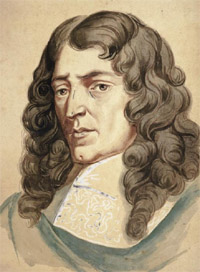Marc-Antoine Charpentier (с 1645 -1704) |
|||||||||||||
Virtually nothing is known about Charpentier's early life - even his date of birth is uncertain. What is generally agreed is that he studied counterpoint and choral writing under Giacomo Carissimi in Rome for a period of time, and readily embraced the Italian music of the mid-seventeenth century. As a result, his initial compositions did not find a ready place in his native France; they were performed away from fashionable circles. Some of his first commissions were from the Duchess of Guise and he remained in her service until her death in 1688, writing motets, dramatic works, and sacred material for the convents in which she had interests. These were all pieces with the unusual feature of being composed specifically for performance by female voices.When Lully moved on from his work with the French dramatists, leaving Moliere without a collaborator, Moliere approached Charpentier. Together they developed productions for his theatrical company, which in time would be known as the Comedie Franause. Charpentier created new overcures and intennedes to replace Lully's, and even after Moliere's death in 1673 continued to work with this tamed troupe.In the early 1680s he was employed by the dauphin, the King's eldest son. He wrote a grand motet to mark the death of Queen Mane-Therese, as well as a number of well-received sacred works and two large-scale dramatic works. He later became music teacher to both the Regent of France and to the Duke of Chartres.Charpentier's love for music and his ability to progress without courtly favours made him a perfect candidate for the position of Maitre dc Musique and composer to the church of St Louis, the mam Jesuit church in Paris. At this time the Jesuits were an influential force; Charpentier wrote Latin dramas for their colleges as well as a great deal of music for their services. So illustrious a position in French musical life allowed the composer to combine his early kalian influences with his interest in drama. In 1693, Medee, Charpentier's only tragedie lyrique, modelled on Lully's work, was performed, but with little success. |
|||||||||||||
 Marc-Antoine Charpentier |
|
||||||||||||
 | |||||||||||||
Saturday, June 23, 2012
Marc-Antoine Charpentier
Subscribe to:
Post Comments (Atom)

No comments:
Post a Comment